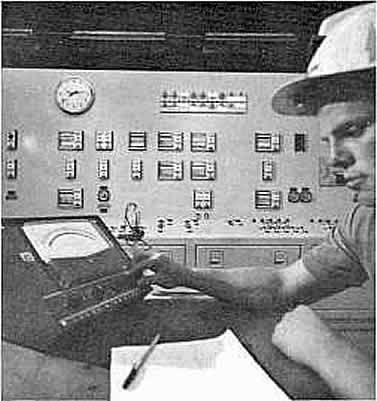Granduc Mine

Milling - Continued
Photo - Richard VanderValk at his controls
FINE CRUSHING
Mill control room with operator Richard VanderValk During its journey from the underground ore pocket a total of 10 conveyors were used to carry the selected millfeed to fine-ore and pebble-storage bins.
As the minus 6-in. ore reached the top of the concentrator building a Tyler double-deck vibrating secondary feed screen scalps plus 4-in. material as feed to the 7-ft. Symons heavy duty secondary cone-crusher and a middle cut for pebble-grinding media. Minus 2-in. undersize passed to a fine-ore screen from which the over 1-in. coarse fraction goes to the 7-ft. Symons tertiary cone-crusher and the minus I-in. to fine-ore storage. Secondary-crusher discharge is screened to yield tertiary-crusher feed and fine ore and tertiary- crusher discharge is directly to fine-ore storage. The pebble- material bin has a capacity of 2260 tons and the three fine- ore bins each have a capacity of 3600 tons.
The tertiary crusher was operating in open circuit but provision was made for a closed circuit whenever required in the future. As in the rest of the plant, electrical, electronic, and mechanical 'control apparatus plays an important role in the smooth running of the crushing section. For instance, each conveyor could be operated from start/stop buttons mounted locally and on the fine-crushing control room console; each conveyor was shut down in the event of a plugged discharge-chute condition with sensing done by a mercury-tilt switch; each conveyor is equipped with emergency stop-pull cords; all start pushbuttons have latch relays and no opportunities were provided for jogging, interlocks require the immediate downstream conveyor to be running before a conveyor could be energized. Belting was supplied by a Japanese manufacturer and was equipped with 3-roll, 35-degree trough, carrier idlers, and flat-return idlers by Hewitt-Robins.
MILLING-CONTINUED